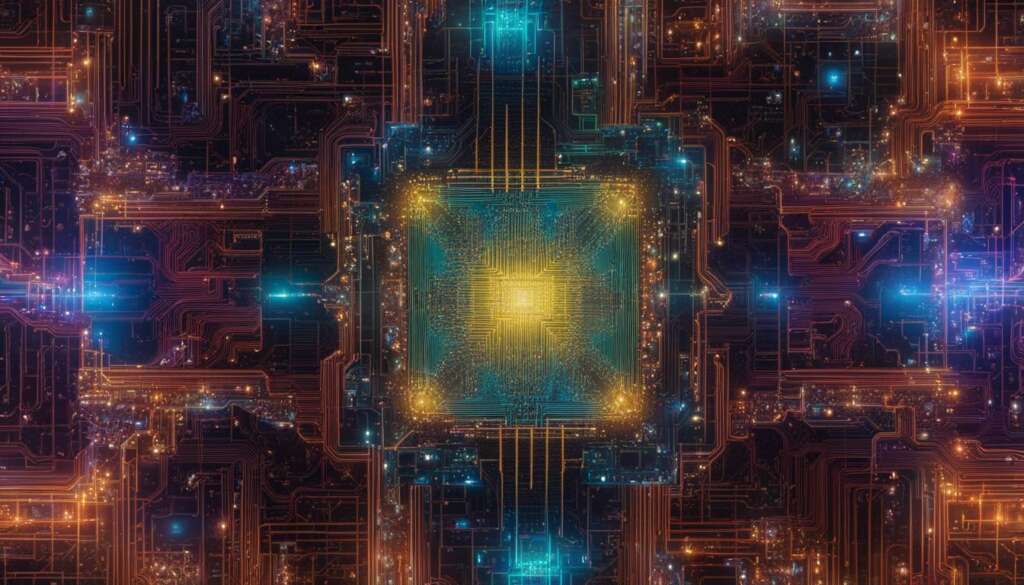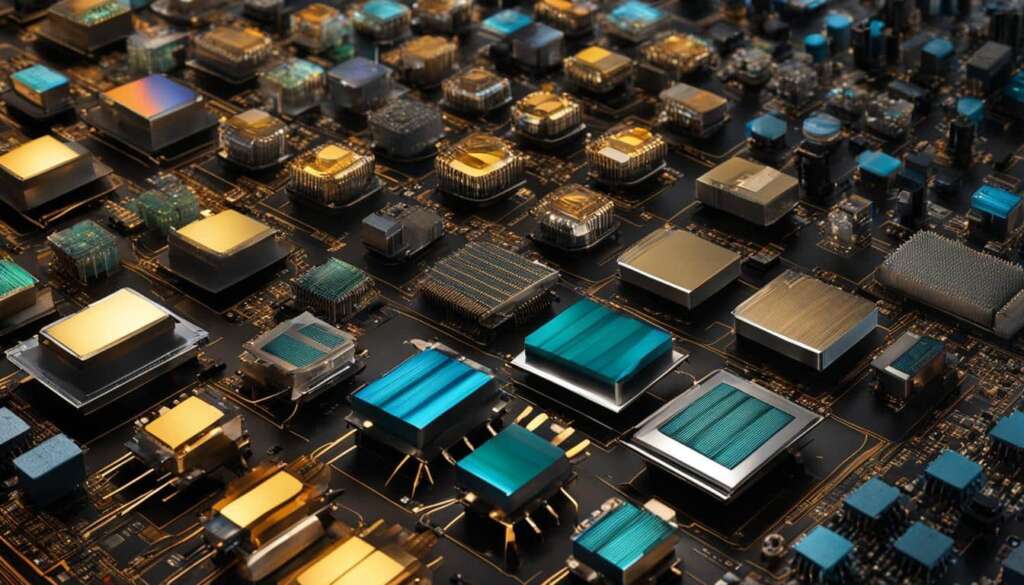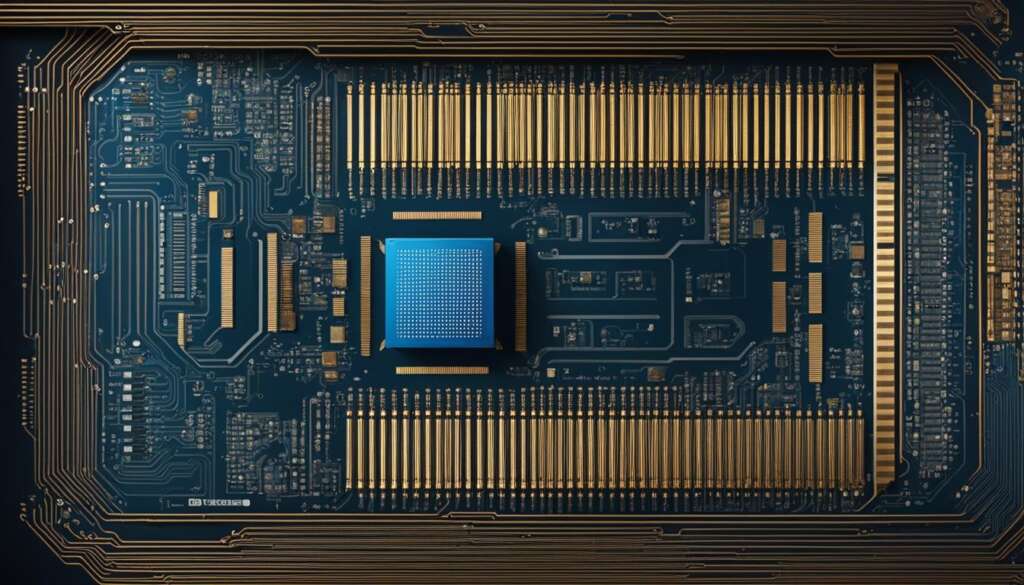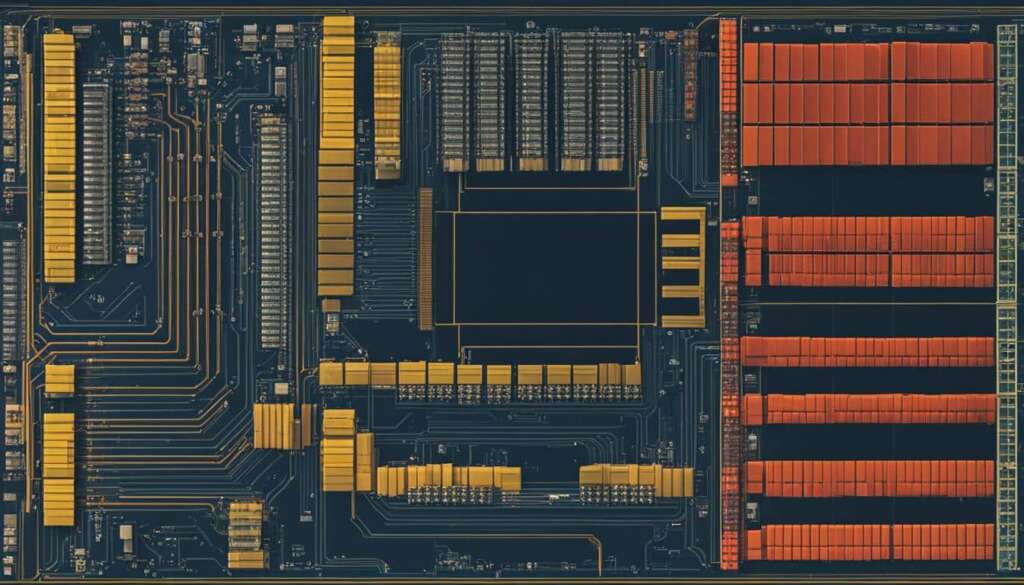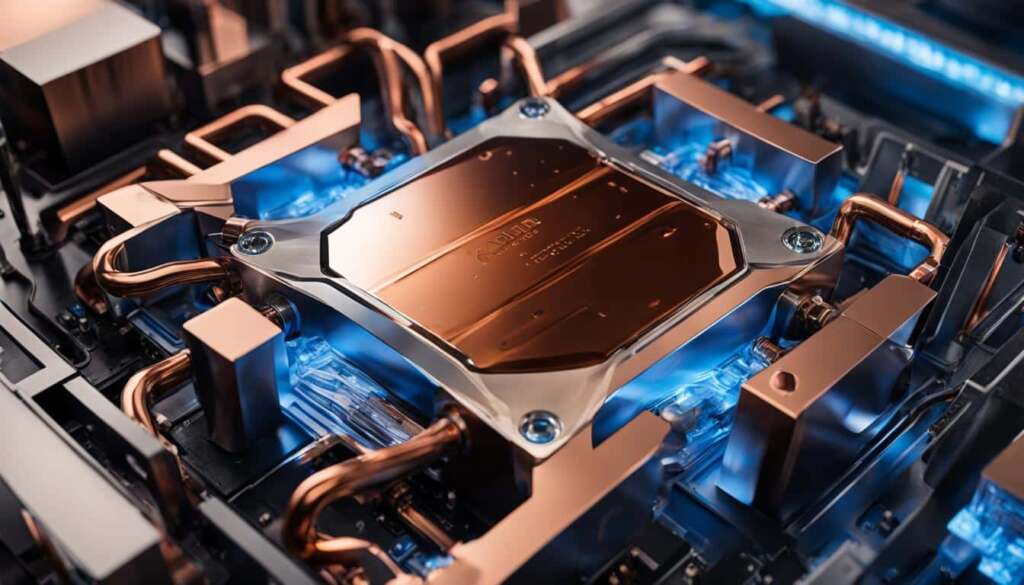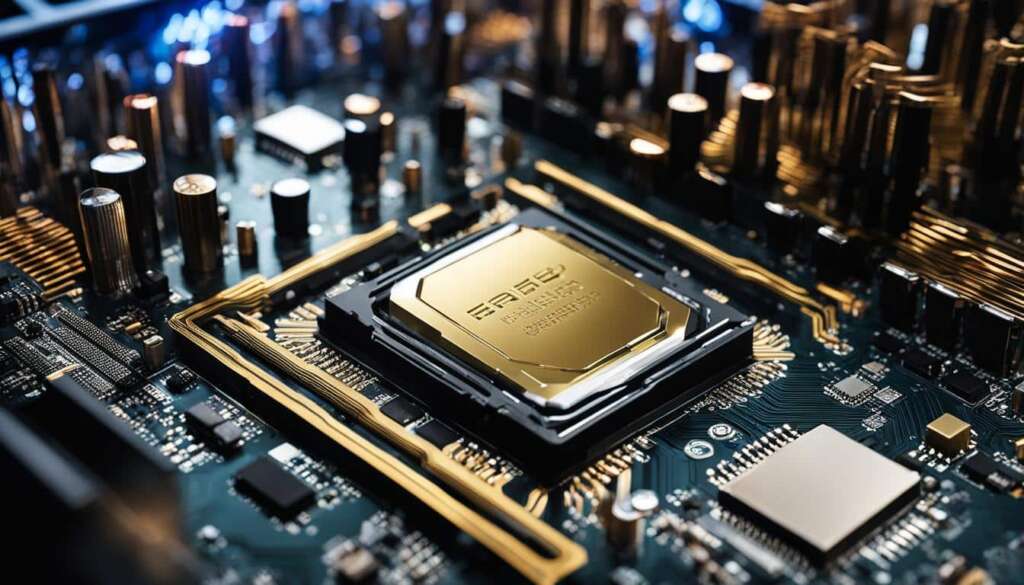Table of Contents
In today’s fast-paced world, the development of processors plays a crucial role in advancing technology. One area that has been driving innovation is nanotechnology. Nanotechnology in processors has been a game-changer since the 1950s and continues to shape the future of processor technology.
Nanotechnology offers a multitude of benefits in processor development. It has been guided by Moore’s Law, which predicts that shrinking devices will lead to improved computing performance and energy efficiency. However, as current devices reach the limits of nanoscale integration, researchers are exploring alternative architectures to meet the growing demands of computing.
One exciting avenue of research is the exploration of non-von Neumann architectures and neuromorphic systems that emulate the high connectivity and parallel processing of the human brain. Northwestern University, along with industry giants like IBM and Intel, are investing in non-von Neumann computing, pushing the boundaries of what processors can achieve.
The potential of nanotechnology in processors is vast, and its continued development holds the promise of revolutionizing the way we compute and interact with technology. As we delve deeper into the world of nanotechnology, exciting advancements are on the horizon, paving the way for a future of faster, more efficient processors.
The Role of CMOS Transistors in Processor Development
CMOS (complementary metal-oxide-semiconductor) transistors have been the foundation of integrated circuits for decades. These transistors have played a significant role in processor development, enabling the creation of smaller, faster, and more energy-efficient devices. The von Neumann architecture, which is based on CMOS technology, has been the dominant model for processor design.
CMOS transistors are essential building blocks in the creation of integrated circuits. These transistors consist of two complementary devices, a p-type and an n-type, which work together to control the flow of electrical current. Through the use of logic gates, CMOS transistors can perform complex operations, making them ideal for processing and storing data in integrated circuits.
The von Neumann architecture, named after computer pioneer John von Neumann, separates the storage and processing of data, allowing for sequential execution of instructions. This architecture has been the standard for processor design, but it has limitations. One of the main challenges is the bottleneck in data transfer between the memory and the processor. This bottleneck has become more pronounced as processors have become faster, leading to a performance gap.
To overcome these limitations, researchers are exploring alternative architectures that can perform calculations within the memory itself. This approach, known as in-memory processing, aims to reduce the need for data movement and improve overall performance. By integrating processing capabilities into the memory, processors can perform operations on data where it is stored, eliminating the need for frequent data transfers.
The Evolution of Processor Architectures
Over the years, there have been several attempts to move away from the von Neumann architecture. One such alternative is the neuromorphic architecture, which emulates the high connectivity and parallel processing of the human brain. Neuromorphic systems, which use CMOS-based circuits, have shown promise in specialized applications such as image and speech recognition.
“The future of processor development lies in exploring new architectures that can overcome the limitations of the von Neumann model.”
While CMOS transistors have been fundamental to processor development, there is a growing need for innovative architectures that can handle the demands of modern computing. The development of new materials, such as carbon nanotubes and graphene, is also opening up new possibilities for processor design. These materials exhibit unique properties that could revolutionize the field of nanoelectronics.
In conclusion, CMOS transistors have played a crucial role in processor development, enabling the creation of smaller, faster, and more energy-efficient devices. However, as processors continue to advance, there is a need for alternative architectures and materials to overcome the limitations of the von Neumann model. Researchers and industry leaders are actively exploring these possibilities to shape the future of computing.
The Rise of Graphical Processing Units (GPUs) in Deep Learning
The field of deep learning has witnessed a major revolution with the rise of graphical processing units (GPUs). Historically, central processing units (CPUs) were the go-to processors for general-purpose computing. However, as deep learning algorithms emerged, it became evident that GPUs, designed for high-speed image processing, were better suited for running these complex algorithms. By harnessing the power of parallel processing, GPUs have proven to be significantly more efficient in handling the vast amounts of data required by deep learning models.
The use of GPUs in deep learning owes its success to their ability to handle massive parallelism. Unlike CPUs, which focus on sequential processing, GPUs excel at performing numerous calculations simultaneously. This parallel architecture allows for faster and more efficient execution of deep learning models, resulting in reduced training times and improved performance.
Companies like IBM have been at the forefront of leveraging GPUs for deep learning applications. They have successfully integrated GPU-based systems into their research and development efforts to accelerate breakthroughs in artificial intelligence and machine learning. By combining the computational power of GPUs with advanced algorithms, researchers can train deep neural networks to recognize patterns, process natural language, and even make predictions based on complex data sets.
Advantages of GPUs in Deep Learning:
- High-speed parallel processing capability
- Efficient handling of large datasets
- Reduced training times for deep learning models
- Improved performance in complex tasks
Gaining a deeper understanding of complex data sets and solving intricate problems are the hallmarks of deep learning. As the demand for more advanced AI applications continues to grow, the role of GPUs in deep learning is only expected to expand. Their ability to efficiently process and analyze massive amounts of data has propelled the field forward, unlocking new possibilities in areas such as computer vision, natural language processing, and autonomous systems.
The Potential of Memristors in Processor Design
As processors continue to evolve, researchers are exploring new technologies that can overcome the limitations of traditional CMOS transistors. One promising advancement in processor design is the development of memristors. Memristors are nanoscale devices that combine memory and electrical resistance, offering the potential for in-memory processing and improved computational efficiency.
Memristors operate on the principle of resistive switching, where their electrical resistance can be modified based on the applied voltage. This unique property allows memristors to store data and perform calculations within the same device, eliminating the need for separate memory and processing units. By enabling in-memory processing, memristors have the potential to significantly enhance the speed and energy efficiency of future processors.
One notable advantage of memristors is their ability to operate at the nanometre scale. With their small size, these devices can be densely packed, leading to higher integration and increased computing power. Additionally, memristors offer non-volatile storage, meaning they can retain information even when power is turned off. This feature is particularly valuable in applications where data persistence is crucial, such as artificial intelligence and big data analytics.
While memristors hold great promise, there are still challenges to overcome before they can be widely implemented in processor design. One key challenge is finding the most suitable materials for commercial production. Researchers are currently exploring various materials, such as transition metal oxides and polymers, to optimize the performance and reliability of memristors. Once these challenges are addressed, memristors could revolutionize the field of processor design and pave the way for a new era of computing.
| Aspect | Memristors | CMOS Transistors |
|---|---|---|
| Operating Principle | Resistive switching | Transistor-based switching |
| Memory and Processing | Combined in a single device | Separate units |
| Size | Operates at the nanometre scale | Operates at the microscale |
| Integration | Higher integration due to small size | Lower integration |
| Power Consumption | Potential for lower power consumption | Higher power consumption |
Table source: Own compilation.
Exploring New Materials for Advanced Processors
As the field of nanotechnology continues to advance, researchers are turning their attention to exploring new materials that have the potential to revolutionize processor development. Materials science plays a crucial role in pushing the boundaries of computing performance and efficiency, pushing the limits of what is possible in the world of nanotechnology. By harnessing the unique properties of these materials at the nanoscale, scientists aim to create processors that are stronger, lighter, and more conductive.

One such material that has garnered significant interest is graphene. Graphene is a single layer of carbon atoms arranged in a unique hexagonal lattice, making it the thinnest and strongest material known to date. Its exceptional electrical conductivity and mechanical strength make it an ideal candidate for next-generation processors. Researchers envision harnessing the power of graphene to create faster and more efficient devices that can revolutionize industries ranging from computing to energy storage.
In addition to graphene, other new materials are also being explored for nanotechnology applications in processor development. Quantum dots, for example, are nanoscale semiconductors that exhibit unique optical and electronic properties. These tiny particles have the potential to enhance the performance of processors by improving energy efficiency and allowing for more precise control of electrons. Moreover, carbon nanotubes, resembling the axons in nerve cells, show promise for emulating the brain’s parallel processing capabilities, making them suitable for neuromorphic systems.
Nanotechnology Applications: A Glimpse into the Future
“The exploration of new materials marks an exciting chapter in processor development. These materials showcase unprecedented properties at the nanoscale, paving the way for advanced computing technologies that were once considered beyond reach.”
The potential applications of these new materials in processor development are vast. They hold the promise of faster, more energy-efficient, and highly functional processors that can meet the exponentially growing demands of today’s technology-driven world. By leveraging the unique properties of these materials, researchers are pushing the boundaries of what is possible in computing, communication, and data processing.
In conclusion, the exploration of new materials in nanotechnology represents an exciting frontier in processor development. Researchers are delving into materials science to discover materials that offer unparalleled electrical, mechanical, and optical properties, with the potential to revolutionize the field of computing. By harnessing the power of materials like graphene, quantum dots, and carbon nanotubes, scientists are paving the way for next-generation processors that are faster, more efficient, and capable of performing complex tasks. The future of advanced processors is bright, and the possibilities are virtually limitless.
The Revolution of 3D Printing in Processor Manufacturing
Nanotechnology is constantly pushing the boundaries of manufacturing, and 3D printing is at the forefront of this revolution. With its ability to create complex structures at the nanoscale, 3D printing has the potential to transform processor manufacturing in ways never seen before. By utilizing advanced pliable materials such as plastics, ceramics, metals, and graphene, components for processors can be printed layer by layer, resulting in customizable and cost-effective manufacturing processes.
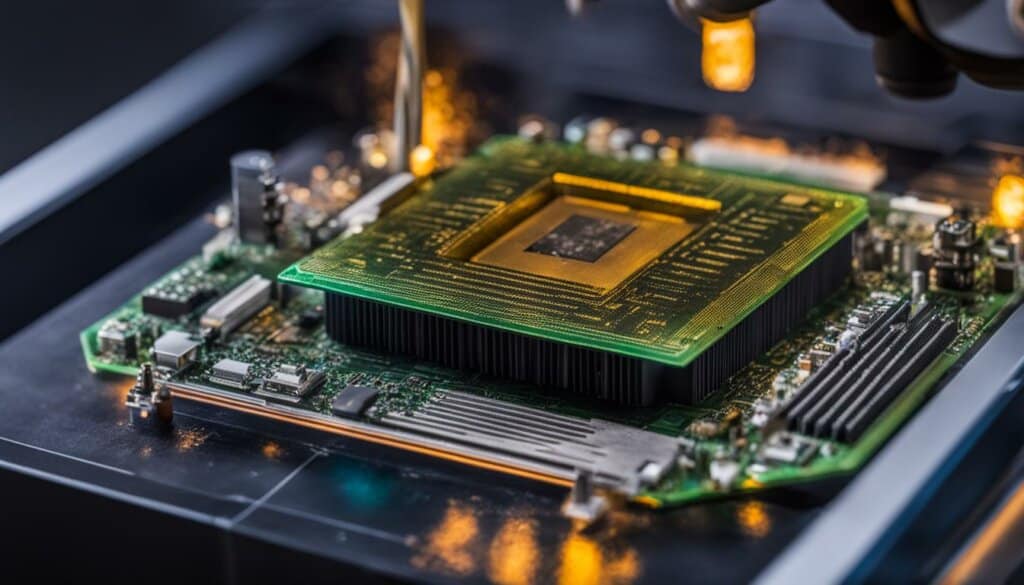
One of the significant advantages of 3D printing in processor manufacturing is its ability to create intricate designs and structures that were previously impossible or extremely difficult to achieve. The nanoscale engineering made possible by 3D printing allows for precise control over the composition and arrangement of materials, enabling the production of processors with enhanced performance and functionality.
In addition to its manufacturing capabilities, 3D printing also offers the potential for rapid prototyping and iteration in processor development. With traditional manufacturing methods, it can be time-consuming and costly to produce multiple iterations of a design. However, with 3D printing, engineers can quickly test and refine their designs, accelerating the development process and bringing new processors to market faster.
Advantages of 3D Printing in Processor Manufacturing:
- Customizable manufacturing processes
- Nanoscale engineering for precise control over composition and arrangement of materials
- Potential for rapid prototyping and iteration
- Cost-effective production of complex structures
Nanomedicine and the Future of Healthcare
Nanotechnology has opened up exciting possibilities in the field of medicine, revolutionizing the way we approach healthcare. One of the key areas of advancement is in nanomedicine, which involves the use of nanoparticles to deliver drugs more effectively and precisely within the body. By utilizing nanoscale particles, drugs can be targeted to specific cells or organs, increasing their therapeutic efficiency and reducing side effects.
Drug delivery systems based on nanotechnology offer a range of benefits. For example, nanoparticles can be engineered to release drugs in a controlled manner, ensuring a consistent and sustained therapeutic effect. These particles can also bypass natural barriers in the body, such as the blood-brain barrier, allowing drugs to reach previously inaccessible areas. Additionally, nanomedicine enables the combination of multiple drugs into a single formulation, enhancing treatment outcomes and reducing the need for multiple medications.
Another promising area of nanomedicine is bioprinting, which utilizes advanced 3D printing technology to create living tissues and even organs. This innovative approach has the potential to revolutionize organ transplantation, as it could address the critical shortage of donor organs. By printing tissues and organs using a patient’s own cells, the risk of rejection could be significantly reduced, leading to improved patient outcomes and quality of life.
| Nanomedicine Benefits | Examples |
|---|---|
| Targeted Drug Delivery | Using nanoparticles to transport drugs to specific cells or organs, improving treatment effectiveness and reducing side effects. |
| Controlled Release | Engineering nanoparticles to release drugs in a controlled manner, ensuring consistent therapeutic effects. |
| Bypassing Natural Barriers | Nanoparticles can traverse natural barriers in the body, such as the blood-brain barrier, enabling drug delivery to previously inaccessible areas. |
| Combination Therapies | Developing formulations that combine multiple drugs into a single treatment, enhancing treatment outcomes and reducing the need for multiple medications. |
| Organ Bioprinting | Utilizing 3D printing technology to create living tissues and organs, addressing the shortage of donor organs and reducing the risk of rejection. |
Nanomedicine is already being commercialized and has the potential for significant future breakthroughs. As researchers continue to explore the applications of nanotechnology in healthcare, we can expect to see further advancements in drug delivery, tissue engineering, and personalized medicine. The future of healthcare is being shaped by nanomedicine, offering new possibilities for improved treatments and better patient outcomes.
Applications of Nanotechnology in Construction and Infrastructure
Nanotechnology is revolutionizing the construction industry, offering new possibilities for stronger, self-healing, and adaptive materials. At the forefront of this innovation is the development of construction materials that incorporate nanoscale engineering, enhancing their properties and performance.
One exciting application of nanotechnology in construction is the development of self-healing materials. These materials have the ability to automatically repair cracks and damages, increasing the lifespan of infrastructures and reducing maintenance costs. By embedding nanocapsules filled with healing agents in the construction materials, cracks can be healed and prevented from spreading, ensuring the structural integrity of buildings, bridges, and roads.

Nanotechnology is also being used to create construction materials with enhanced strength and durability. By manipulating the properties of nanoparticles, scientists are able to develop materials that are stronger, lighter, and more resistant to wear and tear. These advanced materials can withstand extreme conditions, making them ideal for infrastructure projects in harsh environments.
Nanotechnology in 3D Bioprinting
Nanotechnology is revolutionizing the construction industry, offering new possibilities for stronger, self-healing, and adaptive materials.
Another exciting application of nanotechnology in construction is 3D bioprinting. By combining nanotechnology with additive manufacturing techniques, scientists are able to create intricate structures at the nanoscale, including tissues and organs. This technology has the potential to revolutionize regenerative medicine and transplantation, as it allows for the creation of custom-made organs that match the patient’s unique requirements.
| Advantages of Nanotechnology in Construction and Infrastructure | Examples |
|---|---|
| Enhanced strength and durability | – Nanoparticle-reinforced concrete that is stronger and more resistant to cracking |
| Self-healing properties | – Self-healing coatings that repair damages and extend the lifespan of structures |
| Improved energy efficiency | – Nanocoatings that reflect heat, reducing the energy required for cooling |
| Customized manufacturing | – 3D-printed structures with complex geometries and tailored functionalities |
The use of nanotechnology in construction and infrastructure has the potential to revolutionize the way we build and maintain our cities. From self-healing materials to 3D bioprinted structures, nanotechnology is paving the way for stronger, more sustainable, and technologically advanced infrastructures.
Conclusion
Nanotechnology advancements have propelled the future of computing, revolutionizing the way we process information and interact with technology. The integration of nanoscale devices in processors has led to improved computing performance and energy efficiency, challenging the limits of traditional architectures.
Researchers are actively exploring alternative non-von Neumann architectures and neuromorphic systems that mimic the high connectivity and parallel processing of the human brain. This paradigm shift in processor development holds the key to unlocking new levels of computational power and efficiency.
Moreover, the exploration of new materials, such as quantum dots and graphene, has opened up new possibilities for advanced computing. These materials exhibit unique properties at the nanoscale, making them stronger, lighter, and more conductive. Carbon nanotubes, in particular, show promise in emulating the brain’s parallel processing and could be a game-changer in processor design.
In conclusion, nanotechnology advancements in processors are paving the way for the future of computing. With continued research and investment, we can expect to see even more remarkable breakthroughs that will shape the way we compute, interact with technology, and tackle the challenges of our tech-guided world.
FAQ
What is the role of nanotechnology in processor development?
Nanotechnology has been a driving force in processor development since the 1950s, pushing the boundaries of computing performance and energy efficiency.
What is the von Neumann architecture and why is it being challenged?
The von Neumann architecture separates the storage and processing of data in processors. However, this separation creates a bottleneck in data transfer, leading researchers to explore alternative architectures.
How have graphical processing units (GPUs) impacted deep learning?
GPUs designed for high-speed image processing have proven to be more efficient than traditional CPUs for running deep learning algorithms, resulting in significant performance improvements.
What are memristors and how can they revolutionize processor design?
Memristors are devices that combine memory and electrical resistance, enabling data storage and processing on a nanometre scale. Their potential to surpass traditional CMOS transistors is being explored.
What new materials are being explored for advanced processors?
Researchers are investigating the properties of materials such as quantum dots, graphene, and carbon nanotubes to meet the demands of advanced computing and emulate the brain’s parallel processing.
How is 3D printing revolutionizing processor manufacturing?
3D printing allows for the creation of complex structures at the nanoscale, enabling customized and cost-effective manufacturing of processor components using materials like plastics, ceramics, metals, and graphene.
What are the applications of nanotechnology in medicine?
Nanoparticles can be used to transport drugs to precise locations in the body, improving treatment effectiveness and reducing side effects. Bioprinting is also being explored for the creation of living tissues and organs.
How is nanotechnology impacting the construction industry?
Nanotechnology is being used to develop stronger, self-healing, and adaptive materials for infrastructure construction, increasing lifespan and reducing maintenance costs. 3D bioprinting also offers possibilities in regenerative medicine.
What does the future hold for nanotechnology in processor development?
Researchers and industry leaders continue to invest in nanotechnology advancements, with the potential to revolutionize computing and improve how we interact with technology.

